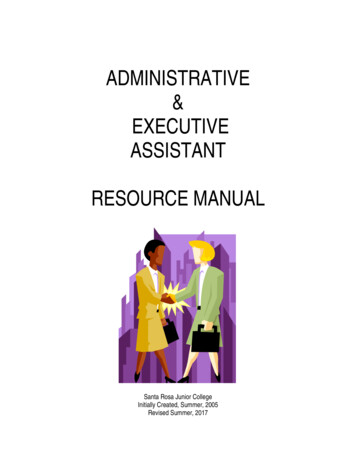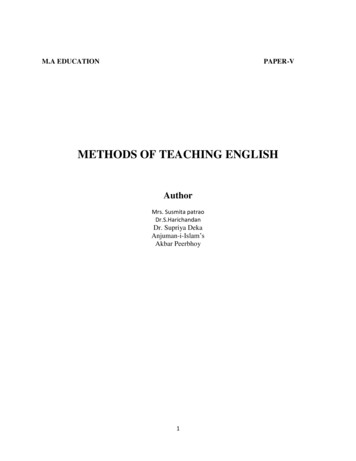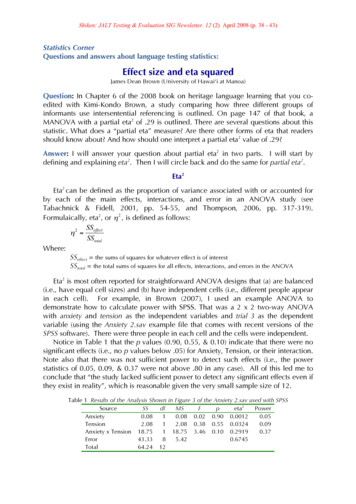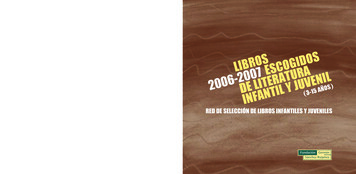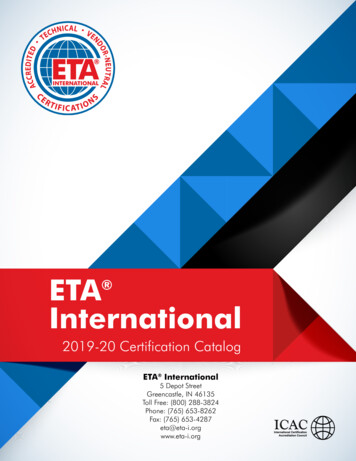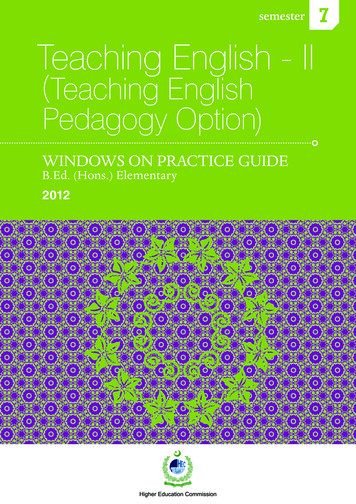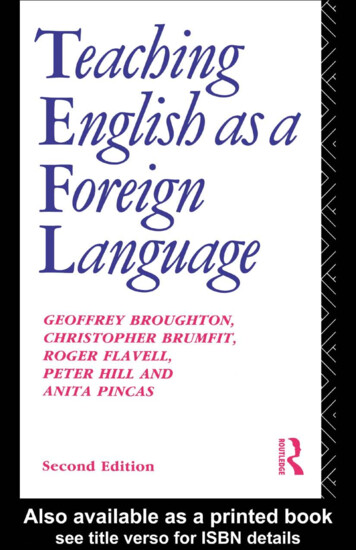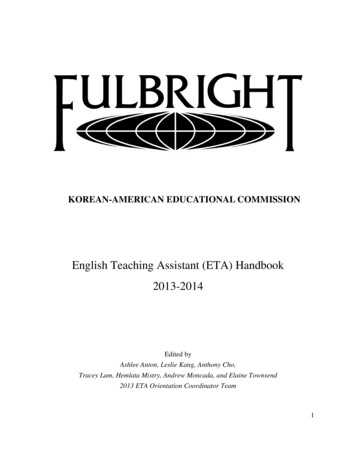
Transcription
KOREAN-AMERICAN EDUCATIONAL COMMISSIONEnglish Teaching Assistant (ETA) Handbook2013-2014Edited byAshlee Anton, Leslie Kang, Anthony Cho,Tracey Lam, Hemlata Mistry, Andrew Moncada, and Elaine Townsend2013 ETA Orientation Coordinator Team1
We must try, through international education, to realize something new in the world -- a purposethat will inspire us and challenge us to use our talents and material wealth in a new way, bypersuasion rather than force, cooperatively rather than competitively, not with the intention ofgaining dominance for a nation or an ideology, but for the purpose of helping every societydevelop its own concept of public decency and individual fulfillment.- Senator J. William Fulbright2
3
Table of ContentsIntroduction to the ETA Handbook .8ETA Program Background and Introduction .9The Fulbright Office .10Key Staff Members .10Getting Ready to Go .11Passport .11Visa .11Travel Arrangements to Korea.12Taxes .12Medical Considerations .13Medical Clearance .12Inoculations .13Mental Health and Well-Being .14Medications .15Medical Care .16Health Insurance .17Medical Talk .17Prescription Glasses and Contacts .17Luggage & Personal Items .18Airline Baggage .18Shipping .18APO.19Excess Baggage Allowance .20Packing .20How to Pack .20Things Provided at Orientation .21Bag 1: at Orientation .21Bag 2: Non-Orientation Items .24Shoes .25Gifts for School and Homestay Family .25Past ETAs’ Thoughts on Packing .26Availability of Everyday Items .28Used Items for Sale at Orientation .29Arrival in Korea .294
Immigration.29Baggage Claim .30ETA Lifestyle.30Summer Orientation .30Placements .32Teaching .32The ETA Role .32Winter Break Program .33The Korean Educational System .34The Schools .34The Students.35The Schedule .36The Co-Teacher .36School Relations .36The Homestay .37Korean Language .39Living in Korea .40Safety .40Money & Financial Matters .41Bringing Money from the U.S. to Korea .41Orientation Stipend .42Regular Earnings .42Banking .43Transferring or Taking Money to the U.S. .43Credit Cards .43Citibank .44Student Loan Deferments .44Taxes .44Communications .44Mail .44Telephone .45Internet & Email .45Facebook & Blogging .46Computers & Electronics .46Laundry & Dry Cleaning .47Travel .485
Public Transportation .48Subways.48Local Buses . 48Taxis .48Domestic Travel .49Airlines .49Trains .49Express Buses .49.Cars .50Overseas Travel .50Food .51Special Diets .52Drinking Water .53Coffee & Tea.53Eating Out .53Availability of "American" Foods .53Entertainment & Information Resources .54Shopping .55Clothing & Shoe Sizes .57Religion and Religious Services .57Korean Culture and Customs: Understanding Korean Society as an ETA .58Race.58Gender .59Sexuality .60Touching .61Body Image .62Korean Manners & Etiquette .63Use of Names .64Tips for Good Etiquette .64Anti-Americanism & U.S. – Korea Relations .65Cultural Adjustment .66Culture Shock.66Points to Consider .67Appendix A: Important Contacts .68Medical Facilities .68Other Useful Numbers .686
Appendix B: Address List for Shipping and Mail .70Appendix C: Korean Holidays .72Appendix D: Useful Websites . .73Appendix E: Recommended Books .767
Introduction to the ETA HandbookThe ETA Handbook is a compilation of information collected from past ETAs and currentFulbright staff members. Its purpose is to prepare ETAs for their arrival in Korea by givingrelevant, general background information and vital details in regards to preparation for the ETAyear. This version of the ETA Handbook supersedes all other information published about theFulbright Korea ETA Program, including past Handbook editions and information on theFulbright Korea website, which may be outdated. Thus, it is imperative that you carefullyfamiliarize yourself with all of the material contained herein prior to your arrival.Questions about the ETA program should be posted in the “New questions for 2013 ETAs forumunder the FAQs section on the ETA Bulletin Board (ETAB: http://eta-board.fulbright.or.kr/).You may also contact the ETA Program Coordinator (eta.coordinator@fulbright.or.kr) if yourquestion is of a more personal nature.8
ETA Program Background and IntroductionThe Fulbright Korea English Teaching Assistant Program began in the fall of 1992, when eightAmericans arrived in Korea to teach English in middle and high schools. The program has growntremendously since then, with approximately eighty English Teaching Assistants (ETAs)confirmed for the 2013-2014 year. The Korean-American Educational Commission (KAEC),Korean Ministry of Education, and U.S. Institute of International Education jointly organize,select, and develop the guidelines for the program.Unlike most Fulbright grants, which focus on research, the Fulbright English TeachingAssistantship is primarily a teaching position. ETAs typically teach from late August to midJuly, including supplementary classes held during the two-month winter vacation. Many ETAsalso use the long winter break period to conduct individual research projects, study Korean, holdan internship in Korea, or travel around Asia. ETAs are “cultural ambassadors” and therefore areencouraged to take advantage of the many opportunities they will have to learn more aboutKorean culture and to share their own culture with Koreans.To help ETAs adjust to life in Korea and prepare for the challenges of working in a Koreanschool and living in a homestay environment, KAEC holds an intensive Orientation trainingprogram each summer for new ETAs. At the end of this Orientation period, ETAs move to theirteaching assignments. New ETAs are placed in schools throughout Korea, excluding Seoul. Allfirst-year ETAs are required to live in a Korean homestay, which is provided by the placementschool.During the academic year, Fulbright holds two conferences. Past years’ conferences were held inGyeongju (located on the mainland) and in Seogwipo (located on Jeju Island). Officially, theconferences are forums to share teaching ideas, handle organizational tasks, and hear from guestspeakers. They are also excellent opportunities for ETA networking, cultural discussions, andproblem solving. Significant improvements in the ETA program have developed over the yearsas a result of these workshops.9
The Fulbright OfficeThe Korean-American Educational Commission (KAEC) operates the Fulbright Program fromits office in Seoul. The KAEC staff maintains contact with ETAs throughout the year by phone,email, and program workshops. ETAs are expected to inform KAEC staff of any importantplans, changes, or problems that they encounter during their grant period. In addition to the ETAProgram, KAEC also manages the U.S. Education Center, ETS testing facilities, and theFulbright Research Grant Program.Key Staff Members Mrs. Jai Ok Shim, Executive Director: Mrs. Shim has more than 20 years of experiencewith Fulbright. She previously worked with the Peace Corps and has an MBA from YonseiUniversity in Seoul. Mrs. Puhui Im, Program Officer: Mrs. Im works with the both the ETA and Researchbranches of the Fulbright program. She maintains contact with many of the ETAs’ hostschools and works to improve those relationships. Mrs. Young Sook Lee, Program Assistant: Mrs. Lee organizes various ETA programs,including workshops and Orientation logistics. She also serves as a liaison between ETAsand their host schools, when necessary. Mrs. Kee Won Lee, Secretary: Mrs. Lee works in the front office on the third floor. Shehandles logistical concerns. Mrs. Mun Kyung Yu, Senior Education Advisor: Mrs. Yu works with the U.S. EducationCenter and Camp Fulbright. Until several years ago, she worked with the ETA Program. Mrs. Sung Won Park, Accountant: Mrs. Park takes care of financial matters, such as ETAshipping reimbursements and other ETA Program costs. Andrew Moncada, ETA Program Coordinator, 2013-2014: Andrew works with the ETAProgram, acting as the chief liaison between the ETAs and KAEC. He was a 2012-2013ETA. Liam Connolly, Executive Assistant, 2013-2014: Liam assists the Executive Director andother Fulbright staff in working with the Fulbright Research Programs. He was a 2012-2013ETA. Ashlee Anton, Leslie Kang, Anthony Cho, Tracey Lam, Hemlata Mistry, AndrewMoncada and Elaine Townsend, Orientation Coordinators (OCs): Ashlee, Leslie, Anthony,Tracey, Hemlata, Andrew, and Elaine will facilitate this summer's Orientation program.Ashlee has spent the last two years as an ETA and is the Chief Coordinator for the 2013 ETAOrientation. Leslie and Anthony are the Senior Coordinators for this year’s Orientation.Leslie has spent the last two years as an ETA and Anthony served as the 2012-2013 ETA10
Program Coordinator. He was also an ETA for the 2011-2012 grant year. Tracey, HemlataAndrew, and Elaine are current 2012-2013 ETAs.Getting Ready to GoPassportYou must bring a passport valid for at least six months after the expected arrival date in Korea(ideally, for the entire grant period). To apply for a passport, obtain an application at a local postoffice or the passport services website (http://travel.state.gov/passport/).Passports should be kept in personal possession at all times while traveling to or from Korea, orin a secure place if staying in one place for an extended period. Lost or stolen passports shouldbe reported to the U.S. Embassy immediately. Any U.S. Embassy can issue a new passportwithin a few days for a small fee. Fulbright recommends making at least two photocopies of thepassport picture page and the Korean visa. One copy should be left at home and one brought withyou to Korea. This will make getting a replacement easier in the event of a lost or stolenpassport. It is smart to bring an extra set of passport photos as well. However, passport photoscan also be taken after your arrival in Korea for a minimal fee at most photo developing shops.It is also recommended that ETAs bring an additional form of identification with a recentphotograph, such as a driver’s license or university ID card. Upon arrival, Fulbright will provideETAs with a Fulbright identification card.If you plan to travel extensively during the winter break, you may want to plan ahead and getextra passport pages before leaving America.VisaThe Fulbright Program in Korea operates under the authority of a bi-national agreement betweenthe Republic of Korea and the United States governments. This agreement entitles Fulbrightgrantees to an “A-3” or “agreement” visa status. This is a special visa status that exempts theholder from the residence control law and permits a stay in Korea for the full period of the awardwithout mandatory extension requests or other administrative procedures. The A-3 visa statusreflects the “official” nature of a Fulbright grantee’s sojourn in Korea.ETAs should request a visa application form from the Korean Consulate General Office in theirgeographic region index.jsp). Be sure to requestan “A-3 Fulbright Visa.” ETAs should state that they are Fulbright grant recipients but should11
not indicate that they will be teaching (to eliminate any confusion about visa status). Includewith the visa application sakorean.pdf) copiesof the IIE and KAEC appointment letters, as well as a self-addressed stamped envelope to havethe visa mailed back to you. Do not mail your passport via regular mail. Overnight mail is themost secure, in which case your self-addressed stamped envelope will also need to be a pre-paidovernight mail envelope. You must send in your passport with your visa application in orderto receive a visa! There is no fee for an A-3 Visa.ETAs should request at least a 20-month visa. In the past, some consulates have given only 14month visas that expired before the grant ended. ETAs who are unable to obtain an A-3 FulbrightVisa, or a visa for the correct length of time, may still come to Korea without a visa. Americancitizens automatically receive a 30-day visitor permit at the airport. Within that period the KAECoffice will arrange for the visa status to be changed to the correct A-3 status and/or the correctlength of time. Notify the ETA Program Coordinator immediately if you have any difficultyobtaining a visa or if you require a visa extension.For Korean-AmericansKorean-Americans who still have Korean citizenship must renounce their Korean citizenship foran A-3 visa. This was made clear at the beginning of your application process. For KoreanAmerican males, you must also file for military exemption to renounce your visa. You must takecare of this at the time of application. Being ineligible for an A-3 visa is grounds for revocationof your grant.Travel Arrangements to KoreaA round-trip flight between the U.S. and Seoul is paid for by the Fulbright program. ETAs willreceive travel and ticketing information from the Fulbright office in May or June. Please notethat the costs for travel plans to other locations en route to Korea are not covered by theFulbright grant. The required arrival time in Korea is the morning of July 6, 2012. ETAs shouldnot make reservations on their own, unless specifically told to do so.TaxesETAs must apply for KOREAN TAX EXEMPTION STATUS for the grant year. Werecommend contacting the IRS at least 2 months in advance and requesting the IRS 6166 form.Bringing the original and scanned copy to Korea is advised, as some institutions/schools requireit in order to be qualified for tax exemption status in Korea. To receive this form, one must apply12
using IRS Form 8802. The application can be found on the IRS website. The application cost isapproximately 85 USD.Medical ConsiderationsMedical ClearanceETAs must submit the IIE medical form to the New York office and have it approved beforethey can be issued a plane ticket to Korea. IIE will send the medical form to you. Do this ASAP,as it takes several weeks to receive clearance from IIE. Please note that Korea does not requirean HIV test for Americans entering the country, but it is strongly encouraged.InoculationsKorean government regulations do not require any inoculations of travelers except for thosearriving from plague, yellow fever, or cholera-infected areas. Some physicians recommendinoculations against such diseases as cholera, hepatitis, polio, tetanus, typhoid, and typhus. Aphysician should be consulted before deciding whether or not to obtain these or any otherinoculations. The Centers for Disease Control and Prevention (CDC) is also a reliable source forinformation (http://www.cdc.gov).The following vaccinations are recommended by Dr. John Linton, MD, a U.S.-certifiedphysician and Director of the International Health Care Center at Yonsei University’s SeveranceHospital:Very Important Diphtheria/Pertussis/Tetanus (DPT): Updated every 10 years with a single booster. If notupdated in the last ten years, it is necessary to start the series over. It is very important todo this before leaving the U.S., as reliable serum is in short supply in Korea.Hepatitis B: Three shots over three months (1 month interval between the first two). Abooster should be administered every five years. Influenza: Annually. Available in Korea.Sometimes Recommended Hepatitis A: A new vaccine does exist and has been approved in Europe. It is available inAsia, and some doctors recommend it for foreigners living in Asia. Japanese B Encephalitis: Two or three shots, separated by one or two weeks with abooster every three years. This disease exists in Korea although it is extremely unlikely13
that a foreigner will contract it. Since the consequences are serious, immunization issometimes recommended. It is possible to be vaccinated after an epidemic is reported.Not Considered Important for KoreaAll of these vaccines can be obtained in Korea in the unlikely event that there is an outbreak ofthe disease: CholeraPneumovax TyphoidNOTE: Gamma globulin is a human serum-derived product and is not recommended. Injectionsof gamma globulin previously recommended for travelers have largely been replaced by the useof Hepatitis A vaccine.Although it is best to obtain inoculations before departure, most inoculations are readilyavailable in Korea. To avoid unnecessary discomfort while traveling, it is recommended thatinoculations obtained in the U.S. be completed at least one week prior to departure. Also, thoseplanning to travel outside of Korea during the year should check the health recommendations forthose specific countries. The International Travelers’ Hotline (800-232-4636) run by the Centersfor Disease Control and Prevention can provide this information (http://wwwnc.cdc.gov/travel/).Mental Health and Well-BeingMental health facilities are limited in Korea, which means English-speaking licensedprofessionals may not be readily accessible. Because you will have been medically approved byIIE, Fulbright assumes you to be healthy at the time your grant period begins. If an issue arisesthat requires medical attention, Fulbright will do everything possible to help you establish anappropriate contact; however, individuals with past histories of depression, eating disorders, orother mental health disorders should think seriously about their ability to cope and adjust inKorean society. Koreans are very up-front and honest about their feelings and perceptions, whichsometimes comes as a surprise to Americans. Koreans largely consider comments aboutsomeone’s weight and appearance as acceptable as talk of the weather. In the past, male andfemale ETAs have been subject to equal amounts of scrutiny and blunt comments regarding theirappearance. Many ETAs cite this as shocking at first but something they either get used to orignore as the year goes on.Fulbright Korea does have a recommended, US and Korea trained psychologist for visits. Shewill be available to ETAs at Orientation and after placements are done as well, with offices in14
both Seoul and Busan. It is possible to get visits and sessions covered by our insurance. Pleasecheck with the Program Coordinator about these issues as you see fit.Regardless of whether or not you have a past history of mental health issues, it would be wise todevelop a strong support network during Orientation. This support network will help you throughdifficult times and provide a “sounding boar
The ETA Handbook is a compilation of information collected from past ETAs and current . Liam Connolly, Executive Assistant, 2013-2014: Liam assists the Executive Director and other Fulbright staff in working with
